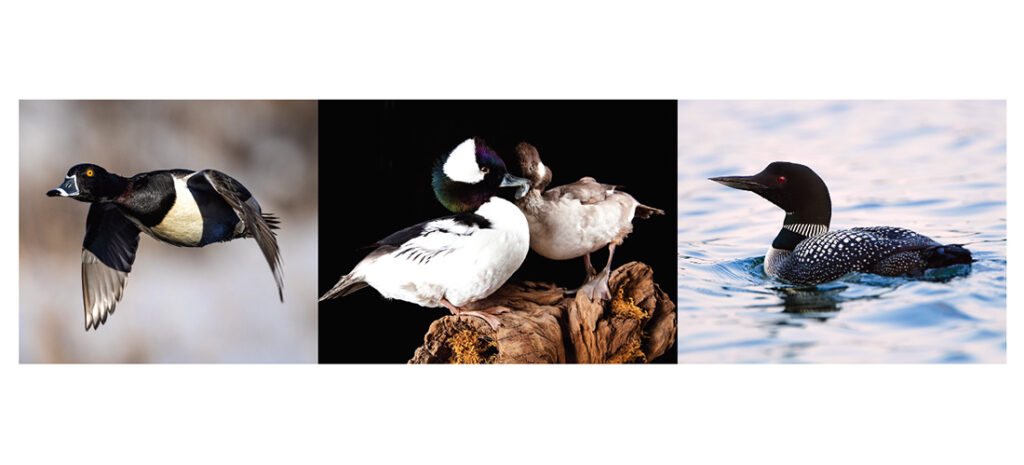Birdwatch

Wintering Waterbirds
Ducks, geese and swans, oh my!
By Susan Campbell
The arrival of cold weather in central North Carolina also means the arrival of waterfowl. Our local ponds and lakes have been documented to be the winter home to more than two dozen different species of ducks, geese and swans. Over the years, as water features both large and small have been added to the landscape, the diversity of waterfowl has increased significantly. Although we are all familiar with our local mallards and Canada geese, a variety of aquatic birds frequent our area from November through March.
Certainly the most abundant and widespread species is the ring-necked duck, flocks of which can be seen diving for aquatic invertebrate prey in shallow ponds and coves. The males have iridescent blue heads, black sides and gray backs. They get their name from the indistinct rusty ring at the base of their necks. The females, as with all of the true duck species, are quite nondescript. They are light brown all over and, like the males, have a grayish blue bill with a white band around it.
The most noticeable of our wintering waterfowl would be the buffleheads. They form small groups that dive into deeper water, feeding on vegetation and invertebrates. The males have a bright white hood and body with iridescent dark green back, face and neck. They also sport bright orange legs and feet, which they will flash during confrontations. The females of this species are also drab, mainly brown with the only contrast being a small white cheek patch. Interestingly, bufflehead is the one species of migratory duck that actually mates for life. This is generally a trait found only in the largest of waterfowl: swans and geese.
There are several types of aquatic birds similar to ducks that can be identified if one can get a good look, which usually requires binoculars. Common loons can occasionally be seen diving for fish on larger lakes in winter, and even more so during spring and fall migration. Their size and shape are quite distinctive (as is their yodeling song which, sadly, they do not tend to sing while they are here).
Be aware that we have another visitor that can be confused with loons: the double-crested cormorant. This bird is actually not a duck at all but is (along with its cousin the anhinga) more closely related to seabirds, e.g. boobies and gannets. It is a very proficient diver with a sharply serrated bill adapted for catching fish. It is not uncommon to see cormorants in their “drying” pose. Their feathers are not as waterproof as those of diving ducks, so they only enter water to feed and bathe. Most of their time is spent sitting on a dock or some sort of perch in order to dry out.
Two other species of waterbird can be found regularly at this time of year: pied-billed grebes and American coots. Pied-billed grebes are the smallest of the swimmers we see in winter, with light brown plumage, short thick bills and bright white bottoms. Surprisingly, they are very active swimmers. They can chase down small fish in just about any depth of water. In some years, American coots can be quite abundant. These black, stocky birds with white bills are scavengers, feeding mainly in aquatic vegetation. They can make short dives but are too buoyant to remain submerged for more than a few seconds. Given their long legs and well-developed toes, they are also adept at foraging on foot. You may see them feeding on grasses along the edge of larger bodies of water or even on the edge of golf course water hazards. PS
Susan Campbell would love to hear from you. Feel free to send questions or wildlife observations to susan@ncaves.com.
